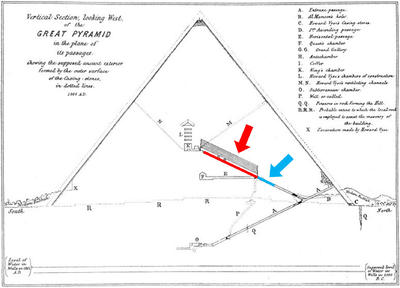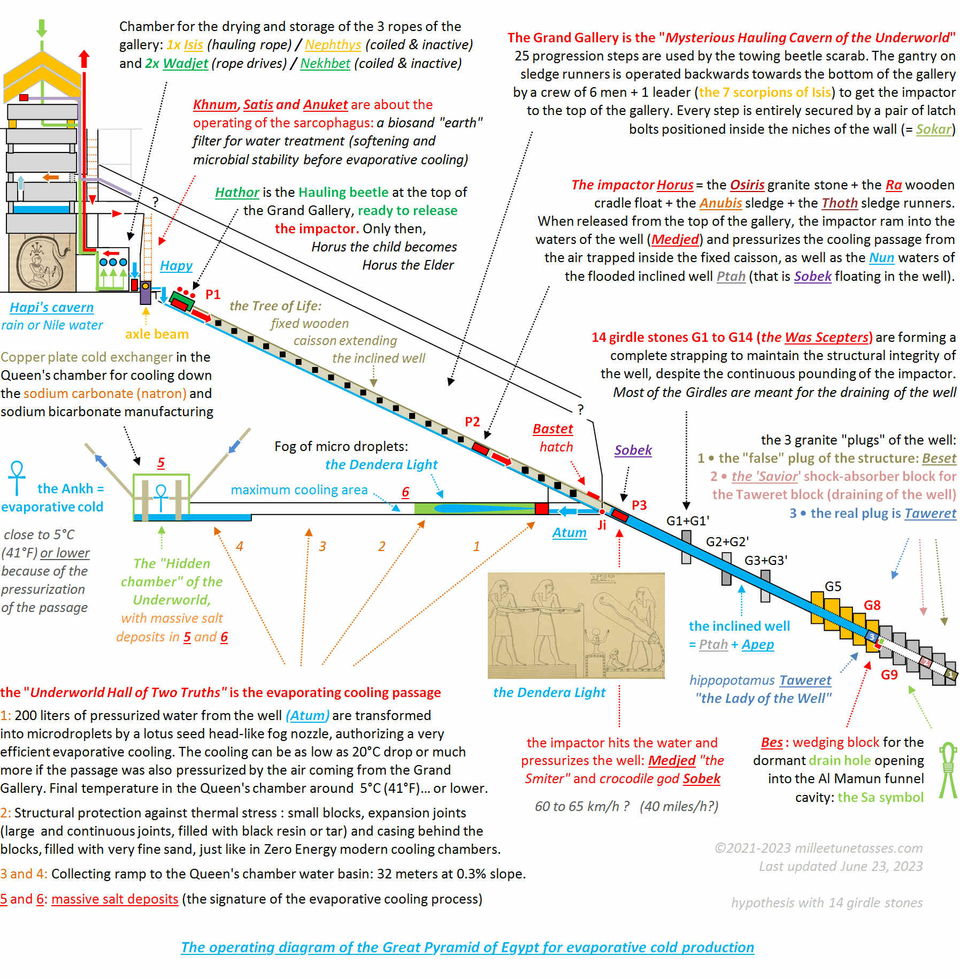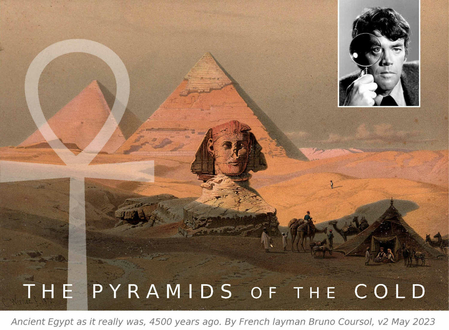- Retour accueil
- Vous êtes ici : Blog The Pyramids of the Cold v2 The Pyramids of the Cold Section 18 • The Apis bull and the ramming impactor's metaphors
The Pyramids of the Cold Section 18 • The Apis bull and the ramming impactor's metaphors
Publié par Bruno Coursol dans The Pyramids of the Cold v2 le 13/05/2023 à 19:16

"Poseidon" water coaster at Europa-Park, by Stefan Scheer: https://en.wikipedia.org/wiki/Water_ride#/media/File:Europapark_Poseidon.jpg
The Pyramids of the Cold v2 (May 2023) • Part C: the composite impactor of the Great Pyramid
Section 18 • The metaphoric representations of the impactor of the Pyramid

Summary: the impactor of the Great Pyramid has been the game changer in the ancient Egyptian attempts to master cold production, and it has been glorified in many ways; whether the emphasis was on its speed, on its ramming capabilities or even the way it moved inside the central wooden caisson of the Grand Gallery, projecting huge water plumes both in front of its path, and on its back.
We've already seen that Medjed, known as "the Smiter", even if appearing in only one of the few surviving papyrus still visible today, is one of these glorifying representations of the impactor; in this Section we'll see that the impactor had also been deified into the Apis bull for its ramming power, as well as in the falcon-headed god of the sky Horus, because the falcon is the fastest of all animals: while stooping, the peregrine falcon soars to a great height, then dives steeply at speeds of over 389 km/h (242 mph).

"The Grand Gallery of the Great Pyramid of Gizeh, looking south, showing the sheer-cut-off of the floor; and the two ramps ascending into the darkness beyond." Great Pyramid Passages Vol 1, 1910 edition by John and Morton Edgar: https://archive.org/details/GreatPyramidPassagesVol11910Edition/page/n301/mode/1up
The Le Scoot Log Flume at Busch Gardens Williamsburg, New-France in Canada, by Zboy zboy: https://en.wikipedia.org/wiki/Le_Scoot_Log_Flume
18.01 The log flume ride model of the impactor ramming into the waters of the inclined well
Pretty much a perfect match, in term of operation.

Dragon Falls Log Flume Ride, at Chessington World of Adventures, Southwest London, UK. Photograph by Chris Sampson: https://en.wikipedia.org/wiki/Log_flume_%28ride%29#/media/File:DragonFalls_Splash.jpg
18.02 The log flume ride model of the impactor ramming into the waters of the inclined well
With the water plumes in front of the log flume ride.

Operating phase P10 of the Grand Gallery: the impactor has been released.

Banebdjedet wielding a scepter of the Was-sceptre, Djed, and Ankh. From the Tomb of Mentuherkhepeshef in the Valley of the Kings. Photograph thanks to kairoinfo4u: https://www.flickr.com/photos/manna4u/3331554556/in/photostream/
18.03 Osiris as Ram-headed Banebdjedet is the one who is giving life, power and force to Ra: the Apis bull and the ram's horns are all about the ramming power of the impactor of the Great Pyramid
The idea that Osiris (i.e. the granite stone weight), 'merged' with Ra in the Underworld (i.e. who was inserted into Ra, the impactor), and that it is him, Osiris who actually gave all his force and power to Sun god Ra (i.e.his potential energy), is actually perfectly depicted into Banebdjed, the soul of Osiris, or rather his Ba which had been associated with the ram.
And there is the ramming metaphor I've been using all along. The power of Ra comes from the power of Osiris, and it is about the force and the power of a ram : both Ra and Osiris were ramming into the inclined well waters.
"Osiris' soul, or rather his Ba, was occasionally worshipped in its own right, almost as if it were a distinct god […] This aspect of Osiris was referred to as Banebdjedet. […] As Banebdjed, Osiris was given epithets such as Lord of the Sky and Life of the (sun god) Ra."
"Ba does not mean "soul" in the western sense, and has to do with power, reputation, force of character, especially in the case of a god. Since the ba was associated with power, and also happened to be a word for ram in Egyptian, Banebdjed was depicted as a ram, or as Ram-headed." Osiris "Ram god": https://en.wikipedia.org/wiki/Osiris
Ram fighting on Wikimedia Commons thanks to Brahim Djelloul Mustapha: https://commons.wikimedia.org/wiki/Category:Ram_fighting

Api or Hapi (Apis, Taureau Consacré a la Lune)", 1823-25, by the French illustrator Léon-Jean-Joseph Dubois, at the Brooklyn Museum: https://www.brooklynmuseum.org/opencollection/archives/image/55326
18.04 The Apis Bull is a representation of the impactor speeding in the Grand Gallery, pushing waves of water in front of him and huge water plumes behind his path
I've been confused a long time about cows and bulls' meaning in the ancient Egyptian religion, probably because both have horns, and I associated them both with the ramming impactor.
But they are really different, even if they are complementary: while Bulls are about the power of the impactor, cows are about the power of the hauling (previous Sections).
Maybe the most beautiful representation of the impactor Bull I know of, is the one on the above image by the French illustrator Léon-Jean-Joseph Dubois. I'm sure the scene looks cute, even if you don't know what it is all about; the Bull is magnificent and the snake as well. The whole image is perfect, there is both balance and power; ancient Egyptian illustrators really knew what they were doing.
But if you understand it, the scene is like exploding to your eyes; it becomes like a 3D image and even a 3D movie; because the scene is about a "raging" Bull speeding and projecting water all around him.
The Apis Bull is a metaphor, a representation of the impactor speeding within the slope of the Grand Gallery after its release. We've seen that the impactor was moving inside a fixed caisson that perfectly extended the inclined well inside the Gallery; and for the impactor to move, water had to be poured in the caisson, so that it could slide in the caisson.
It means that water was pushed ahead of the impactor, creating a wave in front of it; but it also means that water was projected behind its path, creating huge splashes like cars would do on a wet road, or like the boats of water coasters would do.

WhiteWater water rides manufacturer. Shoot the Chute: https://www.whitewaterwest.com/en/products/water-rides/

Stone relief at Wadi Hammamat, Dynasty 17 by kairoinfo4u: https://www.flickr.com/photos/manna4u/25999304796/in/photostream/

18.05 The Flail is all about projected water and with a directional arrow
Because the impactor is moving onto wooden boards covered with water to reduce the friction, water is violently pushed forward in front of Apis' front hooves : both hooves are pushing the snake's body forward. But water is also projected backwards, creating fabulous plumes of water in the path of the speeding impactor : the flail is these plumes of water, and if it looks "broken", it is only an artistic rendering of the idea of water projected backwards. The flail is exactly like a directional arrow, pointing towards where the water is coming from and in which direction it is projected to.

Relief at Wadi Hammamat showing that the flail symbol is all about water. Middle Kingdom Dynasty 11, Nebhepetre Mentuhotep II. Photographed by kairoinfo4u: https://www.flickr.com/photos/manna4u/25932728632/in/photostream/

Le réveil d'Osiris (the Awakening of Osiris) at the Exposition Osiris, Institut du Monde Arabe, by Denis and Gautier Poupeau
Skeleton infographic by the International Bobsleigh and Skeleton Federation: https://www.ibsf.org/en/our-sports/skeleton-info-graphics
18.06 The force and power that Osiris is giving to Ra is all about his high-speed 'skeleton position'
If you don't know what really was representing Osiris, there is very little chance that you can understand his 'awakening' face-down and head-first riding position. But if you know that Osiris was a metaphoric glorification of the stone weight that was giving speed and energy to Ra, the impactor that was ramming into the inclined well of the Great Pyramid, then you can understand his very peculiar 'skeleton position' and why he also has rams' horns.
The Osiris granite weight was the one which gave speed and energy to the wooden impactor, but this Osiris stone couldn't have been operated without the wooden impactor : there had to be a 'vessel' for the Osiris stone. The wooden impactor, Ra was this vessel.

If Ra is represented into a falcon, it is because of its speed and the way it is hitting its prey at high velocity : "The peregrine falcon is renowned for its speed, reaching up to 320 km/h (200 mph) during its characteristic hunting stoop (high-speed dive), making the peregrine falcon the fastest member of the animal kingdom." Ra, as a falcon is all about this high-speed dive and the force of the impact with its prey. https://en.wikipedia.org/wiki/Peregrine_falcon
Ra-Horakhty is a combined deity of Horus and Ra, and is usually depicted as a falcon-headed man. Draw by Jeff Dahl: https://en.wikipedia.org/wiki/Ra#/media/File:Re-Horakhty.svg
Photograph of a high-speed diving falcon by Lassannn, on imgur and also at https://www.facebook.com/wildlifeatrisk/photos/a.442972959170883/1593597324108435/
18.07 The high-speed that Osiris is giving to Ra is all about the force of impact ramming
If Ra is represented into a falcon, it is because of its high speed and the way it is hitting its prey at high velocity: "The peregrine falcon is renowned for its speed, reaching up to 320 km/h (200 mph) during its characteristic hunting stoop (high-speed dive), making the peregrine falcon the fastest member of the animal kingdom."
Ra, as a falcon is all about this high-speed dive and the force of the impact with its prey. The below images are coming from a video where a prairie falcon is hitting a duck at about 90 km/h. On the right image, the falcon is long gone but the duck is already dead : the impact alone killed it.

Prairie falcons are famous for their hard-hitting hunting tactics. Here a wild juvenile female finishes off a drake mallard with a high-speed headshot. Analysis of the video tells us she's moving close to 90km/h when she hits the mallard. Prairie falcons frequently employ this hunting method when dealing with field-feeding waterfowl. The duck is heavier and stronger, therefore the ground struggle is minimized when the smaller falcon delivers a knockout punch. Screenshots from a video posted by falcorusticolus77 on YouTube (contains shocking images): https://www.youtube.com/watch?v=73OvZ_l35Sw
18.08 The impactor ramming into the inclined well waters (Nun) to produce pressurized water (Apep)
I've already talked about the distinction that has to be made between the waters of the well before the pressurization and the pressurized waters strictly speaking.
The 'plain still' waters had been glorified into what have been called the primordial waters of Nun, while the pressurized waters had been represented into the Great Serpent Apep (also Apophis).
"At the beginning of time, when there was nothing but chaos, the sun-god existed alone in the watery mass of Nun which filled the universe. "I am Atum when he was alone in Nun, I am Ra when he dawned, when he began to rule that which he had made. This passage talks about how Atum created everything in human form out of the chaos."
Once the well is pressurized, a small amount of that water is ejected into the horizontal cooling passage, and that is Atum : about 200 liters of pressurized water which every 15 minutes or so passes through the fog nozzle to create a fog of microdroplets of liquid water. This very particular form of water had been glorified into goddess Tefnut (Tef, or 'tf', meaning to spit).
"He (Ra) created Shu, god of air, and the goddess of moisture, Tefnut." https://en.wikipedia.org/wiki/Ra
The above excerpt is by the way, another confirmation that the purpose of the impactor was not limited to produce pressurized water, just like the "awakening" Osiris figure already have suggested it.
If Ra is the one creating Shu, the god of dry and warm air, it is because the fall of the impactor is taking place inside a fixed wooden caisson that was perfectly extending the inclined well, probably to the top of the Grand Gallery.

Diagram of the operating Great Pyramid of Egypt for evaporative cold production (hypothetically for chemical manufacturing cooling of pure sodium carbonate "natron", the salt used for the mummification of pharaohs). When in operation, the elevation of the Great Pyramid was not finished, and it is only after the shutdown procedure and the draining of the inclined well, that the 3 granite plugs were finally close to one another.

The Pyramids of the Cold version 2 (May 2023 - March 2024)
Summary of the study and Table of Contents
Part A: The evaporative cooling process
Section 1 • The horizontal evaporative cooling passage layout
Section 2 • The Dendera Light and the creation of the fog of microdroplets by the fog nozzle
Section 3 • The water cycle glorifying metaphors: Geb, Shu, Nut, Tefnut
Section 4 • The theorization of the evaporative cooling process by Akhenaten and Nefertiti
Section 5 • The theorization of the evaporative cooling process in the Weighing of the Heart
Part B • The inclined well of the Great Pyramid of Giza
Section 6 • The inclined well layout and the girdle stones
Section 7 • The Taweret "Lady of the Well" temporary sealing granite plug of the well
Section 8 • The Bes temporary wedging block immobilizing Taweret
Section 9 • The draining of the well
Section 10 • The Great Serpent Apep and the snake water metaphors
Section 11 • The Was scepter and the control over "snakes"
Section 12 • The beating Heart of the Great Pyramid
Part C • The composite impactor of the Great Pyramid (Horus, Ra, Osiris, Medjed, Sobek...)
Section 13 • The wooden and stone composite design of the impactor: Ra and Osiris
Section 14 • The endlessly immersed Osiris stone and the seed metaphor
Section 15 • The Anubis sledge and the bobsled mask
Section 16 • The sledge runners of the impactor: Thoth
Section 17 • Medjed: the smiter nobody can ever see
Section 18 • The Apis bull and the ramming impactor's metaphors
Section 19 • The crocodile god Sobek impactor (more or less) floating in the waters of the well
Section 20 • The Obelisk and the Benben stone rising from water
Part D • The Grand Gallery's of the Great Pyramid of Giza
Section 21 • The Sacred "sloping paths" of the "oval-shaped cavern of the act of Hauling"
Section 22 • The central wooden caisson of the Gallery: Sekhmet and the Triad of Memphis
Section 23 • The hauling ropes of the Grand Gallery: Isis, Nephthys, Hatmehit, Wadjet and Nekhbet
Section 24 • The hauling Beetle and the Seven Scorpions of Isis
Section 25 • The Great Cow goddess Hathor and the operating cycle of the hauling Beetle
Section 26 • The 10 operating phases of the Grand Gallery
Section 27 • The guide to the Afterlife for the smart traveler and the canopic jars
Section 28 • The scarab amulet glorifications of the hauling Beetle
Part E • The very large and roughly finished sarcophagus of the Great Pyramid
Section 29 • The biosand filter sarcophagus of the Great Pyramid
Section 30 • The Elephantine Triad deification of the biosand filter of the Great Pyramid
Section 31 • The Great Pyramid's operating flat roof and the water supply issue
Part F • Chemical manufacturing and industrial cooling before the Great Pyramid
Section 32 • The Serdab and the "Refreshment of the Gods" Step Pyramid of Djoser
Section 33 • Sneferu's Red Pyramid and the accumulated ammonia
Section 34 • The Disc of Sabu and the Solvay process for pure natron manufacturing
Part G • The tremendous impact of the Great Pyramid on the whole ancient world
Section 35 • The hidden secrets of the Hermetica Emerald Tablet (around 1600 C.E.)
Section 36 • Thor and the magical Hammer in the Great Hall of Bilskirnir
Section 37 • The Churning of the waters of the Ocean of Milk (Hindu mythology)
Section 38 • The Tibetan prayer wheels and the Grand Gallery's operation
Section 39 and Conclusion • The cooling water of spitting Kebechet
Part H • Epilogue
Section 40 • The smiting Ark of the Covenant and the Ten Commandments
Section 41 • The 293 kilograms windlass Staff of Moses and Aaron... and the First Plague of Egypt: water turning into blood
Section 42 • Ezekiel's Four Egyptian pulley "Wheels within the Wheels" and the four angel ropes
Section 43 • David, Saul, two giant Goliaths, five little stones, an aeolian harp... and a weaver's beam
Section 44 • The holy water fonts and the biosand filter
Part I • The magicians of the Great Pyramid of Giza
Section 45 • The Legend of Khufu and the "magician" polymath Imhotep
Section 46 • The two magical eyes of Isis and the brilliant but painful flame of her twin sister's braids
Poster un commentaire
